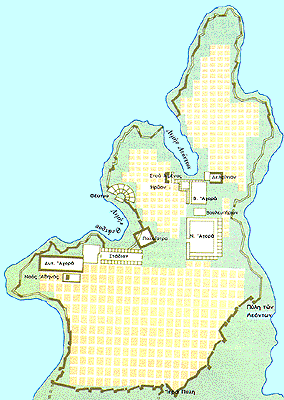

A city in the southern coast of Asia Minor, famous for its great prosperity, mainly
during the period from the 8th to the
Its location was settled in the 2nd millennium BC by Kares or Leleges and subsequently by Cretans, who were brought there by Sarpedon. After the Heraclids descended to the Peloponnese, the Ionians under Neleus, son of the Athenian king Kodrus, colonised Miletus (11th century BC). Since then, especially from 650 BC onwards, the city flourished greatly and became the metropolis of the 80-90 Ionian colonies. It distinguished itself as a commercial and naval power, and became an important centre for science and philosophy, with particular emphasis on the exact sciences. The main exponents of the Milesian School where Thales, one of the Seven Sages of ancient times, and Anaximander.
 Click on the map to visit the Bouleuterion of Miletus |
The subsequent development of the city is closely linked with the important
historical events which took place in the area. It was subjugated to Croesus;
later, after the Persians conquered Lydia, it retained some form of autonomy,
but soon lost it, after a series of unsuccessful revolts. It was liberated after
the naval battle of Mycale (479 BC) and became a member of the Athenian Confederacy from
which it seceded twice. Early in the
Miletus was a typical example of a metropolis of the ancient world. It was fortified, and had four ports of which the central one, known as the Port of Lions, was situated in the eastern bay and was strategically the most important one for the city's defence. After its destruction by the Persians, the city was rebuilt by the Milesian architect Hippodamus on the basis of a new system of city-planning which took his name. It was constructed in regular blocks, and the city centre was divided into three cores corresponding to the three areas of public life: religious, administrative, and commercial. The city thus assumed a special form based on symmetry and balance.
The buildings around the central port date from the classical period. They include the Port Colonnade, the small Agora, the Prytaneion, and the western part of the Temple of Delphinian Apollo. Hippodamus' city plan probably included the Temple of Athena, located west of the Stadium, which dates from the same period.
An intense building activity was evident in Hellenistic times. The temple of
Delphinian Apollo (Delphinium), which was initially built in archaic times, was
given its final form. The whole of the city centre was reshaped, including the north
and south Agora, the Gymnasium and the Bouleuterion. During
this time the Stadium was built, which might have held 15,000. The theatre, initially built
in the
Towards the end of the Roman occupation Miletus once again fell into decline,
especially after the barbarians' invasions starting in the middle of the
Visit the sites:
Paths to Ancient Miletus
A walk through Ancient Miletus
Journey to ancient Miletus